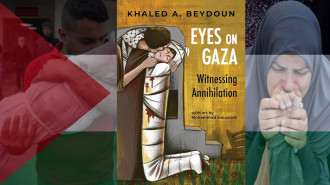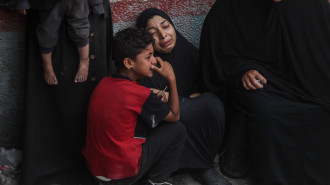
Meet Joe Sacco, the cartoonist drawing a graphic antidote to Palestine apathy

For decades, Joe Sacco’s ‘comics journalism’ has challenged readers’ perceptions of the conflict in Palestine, deconstructing a situation marred by violence.
At the beginning of 2024, Sacco, known primarily for his books Palestine (1996) and Footnotes in Gaza (2009), embarked on a new project to again raise his voice against the crimes perpetrated against the Palestinian people.
Titled The War on Gaza, this series is published in instalments on The Comics Journal’s website (TCJ.com) and is completely free.
In this new series, Sacco’s cartoons serve as an opinion column, where he offers his personal views on the Gaza war that began on October 7, 2023.
Unable to report from Gaza but feeling compelled to respond, Sacco decided to create new comics nearly every week. In them, he relies on satire and dark humour to make his points, as he explained in an interview with The New Arab.
In The War on Gaza, Sacco continues to take a clear and uncompromising position against the violence that has surrounded Palestinians since 1948.
He starts one of the first instalments by asserting that Palestinians are “detested by a cruel world which would sooner see them disappear.”
Sacco’s fans are familiar with his sharp, painfully accurate style. His old-school, hand-drawn stories in black and white are intense, depicting humanity in its full complexity through his inking over pencil sketches.
Illustrating Israel's "genocidal self-defence"
In The War on Gaza, he introduces the thought-provoking term “genocidal self-defence” to describe the tragic events in Gaza. He uses this phrase to provide both sides in the conflict “something to work with.”
In his interview with The New Arab, Sacco clarifies that he views the situation as genocide and believes that the United States and many Western nations are complicit.
Known for his ‘comics journalism’ — a term he coined — Sacco has tackled conflicts in Palestine, Bosnia, Iraq, and African immigration to Malta, among others.
His comic style draws inspiration from Robert Crumb’s satire and is firmly rooted in the autobiographical tradition of 1960s underground American comix.
In his stories, Sacco appears in a caricatured form, wearing a cable-knit jumper and round glasses (which stand in for his eyes). He is depicted as a self-conscious character — biased at times and a privileged outsider — in search of truth.
His first book, Palestine, began as a series of 24- or 32-page comic books released every few months in the early to mid-1990s.
Initially, they sold poorly and were largely ignored, which, he believes, allowed him to find his voice without significant opposition.
His publisher, Fantagraphics Books, remained committed to the project and eventually collected the issues into a single volume.
Higher demand for Palestine content after October 7
The demand for Palestine surged after October 7, 2023. The book, which won the American Book Award in 1996, is a classic of comics journalism, resonating with readers of the past, present, and future.
Fantagraphics Books will release a new hardcover edition of Palestine in September, featuring a new afterword by Israeli journalist Amira Hass and retaining the original 2001 introduction by the late Palestinian-American author and critic Edward Said.
For this early work, Sacco spent two months in the West Bank, the Gaza Strip, and Israel between 1991 and 1992, during the first Intifada.
At that time, Palestinians were often depicted as terrorists by the US media or, at best, as victims.
“I wanted to avoid tropes and instead examine the complexity of Palestinian lives. First and foremost, I wanted to introduce Palestinians to my readers […] as people,” he explains to The New Arab.
Travelling from taxi to taxi and camp to camp, Sacco — who holds a BA in Journalism from the University of Oregon — collected the voices of the people, incorporating them with notes on the region's history and his reflections.
He exposed the recurring humiliations inflicted by Israeli soldiers on Palestinians.
Sacco returned to Palestine to devote more time to what can still be considered his masterpiece, the 400-page Footnotes in Gaza (2009).
Between 2002 and 2003, he visited the Gaza Strip twice to investigate a lesser-known massacre of Palestinians by Israeli soldiers in Rafah and Khan Younis in November 1956.
The book explores the relationship between past and present, childhood memories, and trauma.
Being a Palestinian: One tragedy after another
Despite its more fictional elements, the richness of detail in Sacco’s art provides a deeper truth and context for exploring Palestinian life.
In Footnotes in Gaza, Sacco used paired images to show how little has changed, contrasting scenes from the 1950s with those from the time of writing.
The small, single-story houses in the refugee camp of Khan Younis evolve into concrete buildings, with increased population density adding floors to existing structures.
Rooftops become cluttered with water tanks and rubbish. The Palestinian people in Gaza have become some of the poorest in the Arab region.
Sacco acknowledges that Israelis have also been victims of atrocities. However, as he writes in a brief foreword to Footnotes in Gaza: “As someone in Gaza told me, ‘events are continuous.’ Palestinians never seem to have the luxury of digesting one tragedy before the next one is upon them.”
Joe Sacco was born in Malta in 1960 and grew up in Australia and the United States, where he now resides. He has received numerous awards and accolades, including a 2001 Guggenheim Fellowship and a Time Magazine award for Best Comic of 2000.
Elisa Pierandrei is an Italian journalist and author based in Milan. She writes and researches stories across art, literature, and the visual media. Elisa holds a master's degree in Journalism and Mass Communication from the American University in Cairo (2002), after graduating in Arabic Language and Literature at Ca' Foscari University in Venice (1998).
Follow her on X: @ShotOfWhisky






 Follow the Middle East's top stories in English at The New Arab on Google News
Follow the Middle East's top stories in English at The New Arab on Google News


